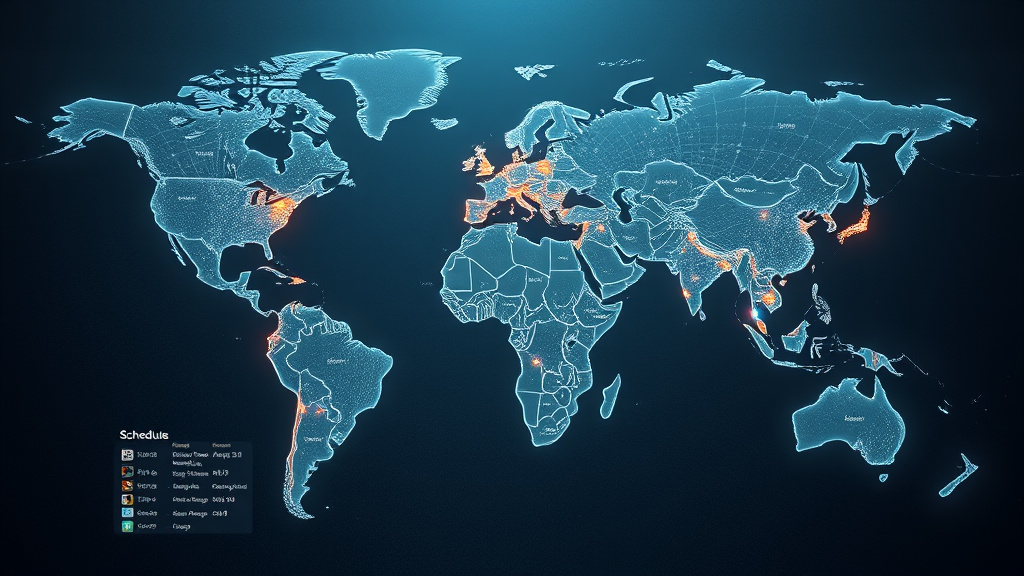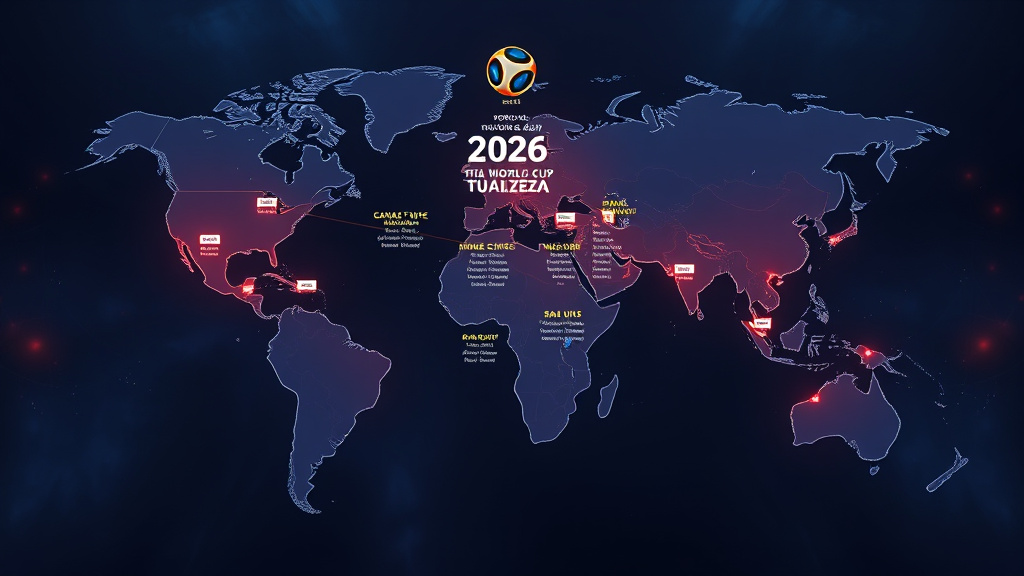The upcoming World Cup 2026 football schedule and venues promise to mark a historic chapter in international soccer. As the pinnacle of sporting events, the FIFA World Cup has historically captivated millions of fans around the globe. With a record-breaking format, expanded venues, and new host nations, the 2026 tournament is poised to redefine the experience. This blog delves into the comprehensive schedule outlining the matches, the iconic venues that will host these exhilarating games, and the significance of this grand event in the world of football. For fans eager to follow every detail, F168 offers a dynamic platform to explore fixtures, track results, and stay connected with the pulse of the tournament. It’s more than just updates — it’s an immersive way to live the drama of 2026 as it unfolds.

An In-Depth Look at the World Cup 2026 Football Schedule
The world cup 2026 football schedule and venues are not just dates and stadiums; they’re a carefully curated roadmap guiding fans through nearly a month of intense competition. Set across multiple cities and countries, the schedule accommodates a larger format, increasing the excitement and unpredictability for fans worldwide. This year, the tournament will feature an unprecedented 48 teams, up from the traditional 32, boosting the number of matches and expanding the overall experience.
This schedule is strategically designed to maximize both competitive fairness and fan engagement. The group stages, knockout phases, and finals are structured to ensure each team has ample opportunity to perform while maintaining a high level of excitement throughout. The distinct timings of the matches consider varying time zones, allowing fans from different parts of the world to follow live as their favorite teams compete on the global stage.
From opening ceremonies to the grand finale, understanding the world cup 2026 football schedule and venues enhances anticipation and helps fans plan their viewing experiences. The schedule emphasizes prime match times, balancing between European evenings, North American mornings, and other global time zones. This logistical planning demonstrates FIFA’s commitment to making the event accessible and enjoyable for fans everywhere, regardless of their location or time preferences.
The Group Stage: Building The Tension
The group stage is the foundation of the World Cup, where teams are divided into groups to compete in round-robin matches. This format ensures that each team plays multiple games, allowing for the best teams to emerge based on consistency and skill. The 2026 schedule introduces some unique features, including more matches and possible adjustments to accommodate the expanded tournament size.
FIFA’s timetable for the group stage is designed to optimize fairness and television viewership. Matches are scheduled strategically so that teams from different time zones don’t face undue fatigue. This thoughtful planning enhances the fairness of the competition and maintains high energy levels for players and fans alike. The group stages will run across various cities, providing diverse atmospheres and fan experiences, from bustling urban stadiums to iconic historic grounds.
Fans can expect to see the early adrenaline rush as the groups take shape, with every game potentially impacting the knockout stage qualification. The schedule aims to keep suspense high, with multiple pivotal matches happening in quick succession. The game timings are designed to allow viewers worldwide to catch marquee matchups, fostering a global community united through football.
Knockout Rounds – The Road to Glory
After the intense group stages, the tournament transitions into the knockout rounds, where only the top teams advance. This phase is characterized by high-stakes matches, where a single game can determine a team’s fate. The world cup 2026 football schedule and venues allocate ample time for these exciting encounters, with matches spaced to give teams adequate rest while building anticipation among fans.
The knockout stage includes round of 16, quarter-finals, semi-finals, and the final match. These games are scheduled with prime broadcasting hours in mind, ensuring maximum global viewership. The schedule has been crafted to prevent over-fatiguing players, allowing for competitive matches that uphold FIFA’s reputation for high-quality football.
Every game in this stage is a potential historic moment; fans anticipate dramatic shootouts, memorable goals, and underdog stories. The knockout rounds are where legends are born, and the schedule’s thoughtful design emphasizes the importance of those moments. By spacing games evenly and configuring match timings for maximum engagement, FIFA exemplifies its commitment to producing a spectacular event that unites football enthusiasts worldwide.
The Iconic and State-of-the-Art Venues for World Cup 2026
Choosing venues for the world cup 2026 football schedule and venues involves balancing historic significance with modern infrastructure. These stadiums are more than just venues; they are embodying the spirit of innovation, culture, and hospitality. The 2026 World Cup will be hosted across several host cities in three North American countries—United States, Canada, and Mexico—which introduces an exciting mix of geography, ambiance, and fan experience.
Each venue has been selected for its capacity, facilities, accessibility, and ability to provide an electrifying atmosphere that enhances the players’ performances and leaves lasting impressions on spectators. This expanded geographical spread not only increases accessibility but also promotes regional pride and tourism.
North American Venues: The Powerhouses of the Tournament
The United States, being one of the largest host nations for the 2026 World Cup, features a constellation of impressive stadiums. These venues range from iconic, historically significant grounds to ultra-modern arenas with state-of-the-art facilities. The flagship stadiums include some of the largest in the world, accommodating tens of thousands of fans, ensuring an electric environment for critical matches.
In the United States, cities like Los Angeles, New York, Dallas, and Atlanta are expected to play host to some of the tournament’s marquee games. These cities boast stadiums with cutting-edge infrastructure, offering fans exceptional comfort, entertainment options, and fan engagement zones. The US venues are strategically located in major metropolitan areas, thus making it easier for international fans to access and travel between matches seamlessly.
Canada contributes with venues that boast impressive architectural designs fused with modern sports technology. These Canadian arenas are expected to host several group stage matches and potentially knockout games, highlighting the country’s increasing prominence as a global sports destination. The venues reflect Canada’s multicultural spirit and innovative design philosophy, promising a vibrant, welcoming atmosphere.
Mexico’s venues provide a rich blend of history and modernity. Some stadiums have been essential to Mexican football history, hosting legendary matches, while others have been recently renovated or built anew for this global event. The passionate Mexican fans will undoubtedly add a fiery backdrop to these tournaments, creating unforgettable football moments.
New and Renovated Venues: Meeting the Demands of a Global Showcase
For the 2026 tournament, FIFA has invested heavily in enhancing existing stadiums and constructing new ones to meet the expectations of a modern global audience. These venues are designed with sustainability, fan comfort, and cutting-edge technology in mind. The venues reflect a commitment to environmental responsibility, incorporating renewable energy sources, efficient cooling systems, and innovative crowd management features.
New stadiums will incorporate features to enhance fan interaction, such as large open concourses, immersive screens, and dedicated zones for activities beyond the match. These features aim to foster a sense of community and celebration, making each game not just a sporting event but a cultural festival. Additionally, these stadiums are built with accessibility as a priority, ensuring that everyone from disabled fans to families with children can enjoy the event comfortably.
Renovations to existing venues preserve their historic significance while upgrading infrastructure for safety and technological needs. These modifications ensure modern fans experience comfort without sacrificing the stadiums’ inherent character. The blend of the old and new venues creates a diverse ambiance, enriching the overall tournament experience for attendees.
The Legacy and Impact of Selected Venues
Beyond the matches, the world cup 2026 football schedule and venues will leave a lasting legacy in each host city. These venues are designed to be multi-purpose, with the potential for concerts, sports, and community events long after the competition concludes. This legacy approach ensures that the economic and social benefits endure well into the future.
The infrastructure improvements brought by hosting the World Cup will serve local communities, fostering urban development, tourism, and international recognition. The stadiums are expected to become symbols of modernity and cultural pride, inspiring local youth and boosting regional economies through tourism and events. They exemplify a commitment to sustainable development, ensuring that the event’s benefits extend beyond the tournament itself.
Hosting the world cup 2026 football schedule and venues across these major cities is also a strategic move aimed at distributing the economic benefits and global exposure more evenly. Regions that might not traditionally host such large-scale sporting events will now have a chance to showcase their culture and hospitality on the world stage. This inclusivity enhances the global appeal of the tournament and encourages future investments. Platforms like About F168 highlight not just the fixtures and venues, but also the cultural and financial narratives behind them. This makes the tournament more than a sporting spectacle — it becomes a lens through which to view global connection.

Conclusion
The World Cup 2026 football schedule and venues represent a pinnacle of global sporting excellence, combining innovative planning, expansive geographic reach, and state-of-the-art infrastructure. The timeline ensures that each phase of the tournament — from the lively group stages to the electrifying knockout games — is optimized for excitement and fairness. Meanwhile, the diverse selection of stadiums across North America offers a blend of history, modernity, and sustainability, creating memorable settings for football’s biggest celebration. This event promises not only to entertain millions but also to leave a long-lasting legacy for host cities and international football, uniting fans worldwide in their passion for the beautiful game.